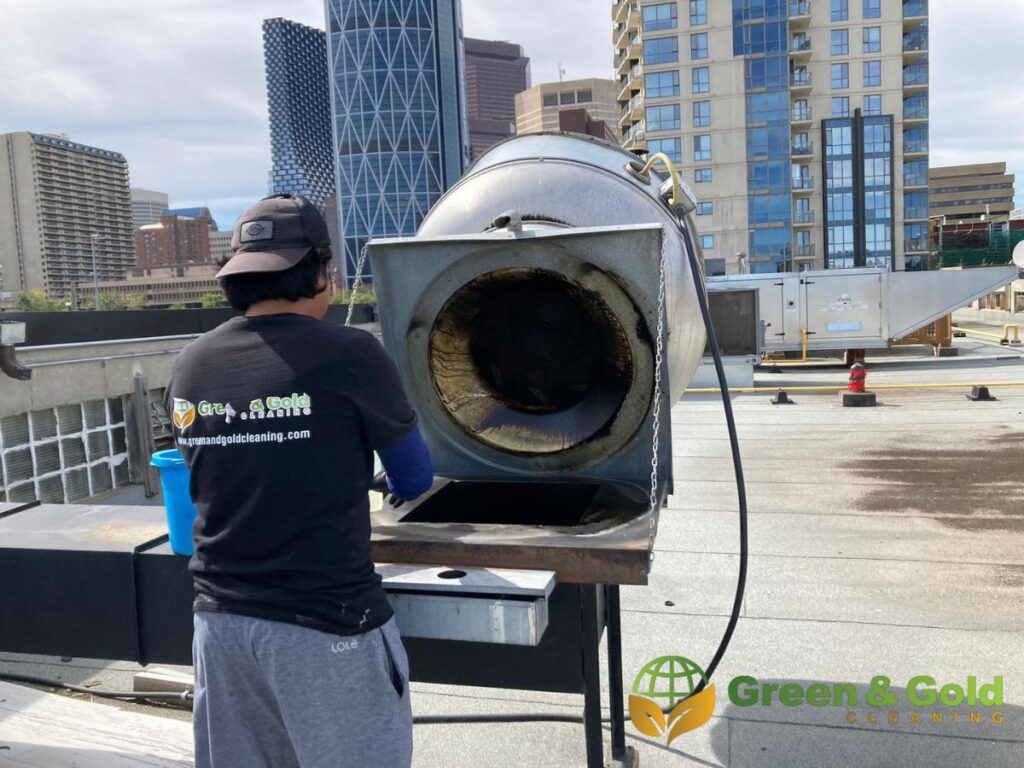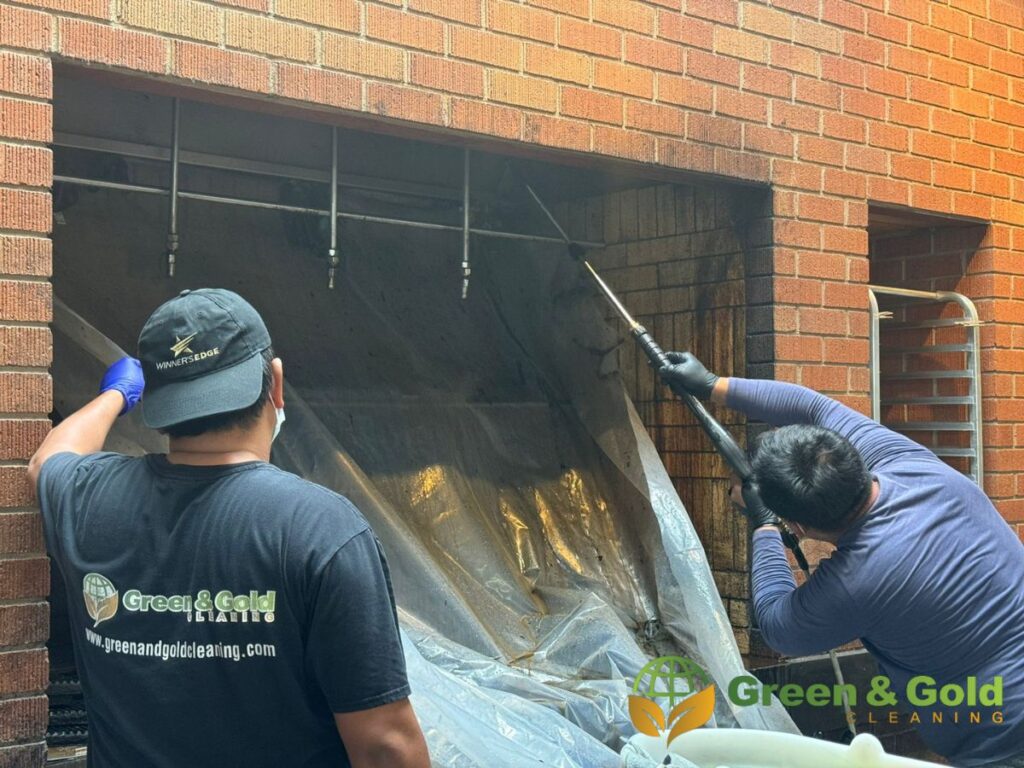Maintaining a clean kitchen hood is crucial for any cooking space, particularly in Calgary, where grease buildup can pose serious health and safety risks. Kitchen hood cleaning in Calgary is often overlooked, but it plays a vital role in enhancing air quality and preventing fire hazards. A well-maintained kitchen hood not only improves your cooking area’s efficiency but also minimizes fire risks. In this blog post, we’ll outline essential tips for effective kitchen hood cleaning that will help you maintain a safe and hygienic cooking environment in your home.

Understanding the Importance of Kitchen Hood Cleaning
The kitchen hood, often referred to as a range hood or exhaust hood, serves to capture smoke, steam, grease particles, and odors released during cooking. Over time, grease accumulates in the hood’s filters and ducts, diminishing its performance and potentially leading to fire risks. Regular kitchen hood cleaning in Calgary not only promotes a healthier kitchen environment but also extends the lifespan of your kitchen equipment. Notably, the buildup of grease can cause unpleasant odors and even create a breeding ground for bacteria, making it even more essential to keep this area clean.
Potential Risks of Neglecting Hood Maintenance
Ignoring kitchen hood maintenance can lead to various problems beyond just a dirty appliance. Grease buildup can significantly reduce air quality in your kitchen, affecting both taste and health. This accumulation can even contribute to higher energy bills, as a clogged hood requires more power to ventilate effectively. Furthermore, during cooking, grease and smoke can escape into your home, leading to unhealthy indoor air and potentially damaging appliances and surfaces. According to the National Fire Protection Association (NFPA), kitchen equipment is a leading cause of home fires, underscoring the importance of regular maintenance.
Essential Tips for Effective Cleaning
1. Establish a Cleaning Schedule
Establishing a routine cleaning schedule is crucial for your kitchen hood’s efficiency. For residential kitchens, a monthly cleaning is generally sufficient; however, heavier users may consider cleaning every two weeks. In commercial settings, especially those with intensive cooking operations, weekly cleanings are often required. Adhering to a schedule helps prevent the buildup of grease and grime, making each cleaning session more manageable. Set reminders on your calendar and encourage family members or staff to participate in the kitchen hood cleaning in Calgary process, fostering a culture of cleanliness and safety.
2. Gather Appropriate Cleaning Supplies
Before you begin the cleaning process, gather the necessary supplies. Essential items include:
- Degreasing cleaner: Opt for non-toxic, biodegradable options to minimize environmental impact.
- Soft cloths or sponges: Microfiber cloths are excellent for non-abrasive cleaning.
- A brush with soft bristles: This helps remove stubborn grease without damaging the surfaces.
- A bucket of hot, soapy water: Hot water helps break down grease more effectively.
- Gloves: Protect your hands while handling cleaning products.
- A vacuum cleaner with a hose attachment: For deeper cleaning, especially around difficult areas.
3. Turn Off the Power and Prepare the Area
Before starting, ensure that the kitchen hood is turned off and cool to the touch. It is vital to remove any removable filters or components to clean them separately. Lay down a tarp or old newspapers on the counter to catch drips or debris during the cleaning process. Taking these precautions minimizes the risk of electrical hazards and keeps your kitchen space organized.
4. Clean the Filters
The filters are among the most crucial components of the kitchen hood and require special attention. For metal filters, soak them in hot, soapy water and scrub gently with a brush to remove grease. Rinse thoroughly and allow them to dry completely before reassembling. If your hood has charcoal filters, remember that these are not cleanable and must be replaced periodically according to the manufacturer’s instructions. Regularly replacing filters can significantly enhance the performance of your kitchen hood, improving air quality during kitchen hood cleaning in Calgary.
5. Clean the Exterior
After addressing the filters, proceed to clean the exterior surfaces of the hood. Utilize a degreaser or a mixture of vinegar and water; the vinegar acts as a natural disinfectant. Wipe down the exterior with a soft cloth, avoiding abrasive materials that may scratch the surface. Pay close attention to areas that typically accumulate grime, such as the edges and the area surrounding the hood’s installation. Not only will this enhance the appearance of your kitchen, but it will also prevent the spread of bacteria.
6. Address the Ductwork
For comprehensive cleaning, inspect the ductwork connected to the hood. If you notice significant grease buildup, it may require professional cleaning, especially in commercial kitchens. Regular inspection of the duct system can prevent dangerous conditions from developing and ensure compliance with fire safety regulations. Many local fire codes require commercial kitchens to have annual inspections, making this an essential maintenance task for restaurant owners. The U.S. Environmental Protection Agency (EPA) provides guidelines on maintaining indoor air quality, which includes proper kitchen ventilation.
7. Reassemble and Test
Once all components are cleaned and dried, reassemble the kitchen hood carefully. Before putting the appliance back into regular use, conduct a quick test to ensure everything is functioning correctly, including the fan and lights. Listen for any unusual sounds and check for proper airflow; these are indicators that your hood is in good working order.

Kitchen Fire Safety Tips
To further enhance kitchen safety, consider the following tips from the NFPA:
- Stay in the kitchen: Always stay in the kitchen while frying, grilling, boiling, or broiling food to prevent fires.
- Keep flammable items away: Ensure that oven mitts, wooden utensils, and food packaging are kept away from the stovetop.
- Use a timer: Set a timer to remind you that you are cooking, especially when baking, roasting, or boiling.
- Smother small grease fires: Keep a lid nearby to smother small grease fires by sliding the lid over the pan and turning off the burner.
- Follow NFPA 96 Standards: Adhere to NFPA 96 for ventilation control and fire protection of commercial cooking operations.
By implementing these safety tips, you can significantly reduce the risk of kitchen fires and create a safer cooking environment for you and your family.
Why Choose Clean It All?
If you find yourself overwhelmed by the cleaning tasks necessary to maintain a safe kitchen, Clean It All is here to assist you. Our professional cleaning services ensure that your kitchen hood and other areas are thoroughly cleaned and maintained. Here’s why you should choose us:
- Supervisor on-site: We ensure quality control with a supervisor present during cleaning.
- After-cleaning report: Receive a detailed report after every cleaning session.
- Commercial cleaning insurance up to $5 million: We are fully insured to give you peace of mind.
Our Services Include:
- Kitchen Cleaning
- Everyday Janitorial Service
- Floor Maintenance
- Sanitation

Conclusion
Effective kitchen hood cleaning is essential for maintaining a safe and hygienic cooking environment. By establishing a routine cleaning schedule, using the right supplies, and addressing all components of the hood, you can enhance kitchen safety and efficiency. However, if you find yourself struggling with these tasks or simply don’t have the time, our team at Clean It All is ready to help.
Call us at 250-300-5460 or email us at service@greenandgoldcleaning.com. Whether you need commercial or residential cleaning in Calgary, request a FREE quote here. Explore our cleaning offers and take advantage of our competitive pricing and great deals! Let us handle the hard work while you enjoy a fresh, clean environment—your satisfaction is our priority!
How useful was this post?
Click on a star to rate it!
Average rating 0 / 5. Vote count: 0
No votes so far! Be the first to rate this post.
We are sorry that this post was not useful for you!
Let us improve this post!
Tell us how we can improve this post?



